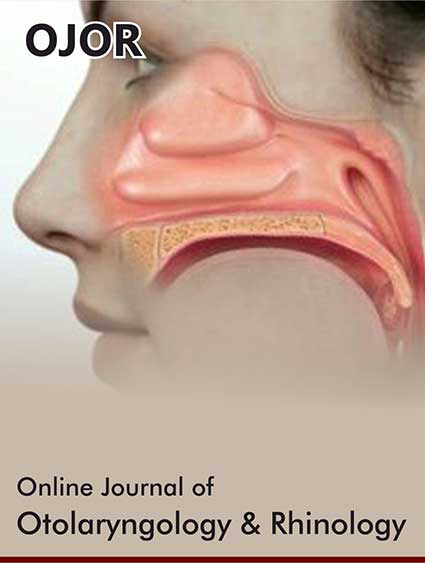 Research Article
Research Article
Comparison of Conventional Single-Frequency Tympanometry with Pressure-Less Acoustic Immittance Measurements of Pathological and Normal Middle Ears
Moayad Anbari1, Shirin Zhumabaeva2, Munar Beishenova2, Dörte Fischer1,3, Shayirbek Sulaimanov2 and Tino Just1*
1Department of Otorhinolaryngology, Head and Neck Surgery, KMG Klinikum, Güstrow, Germany
2Department of Otorhinolaryngology, The National Center of Maternity and Childhood Care, Bishkek, Kyrgyzstan
3Department of Audiology, KMG Klinikum, Güstrow, Germany
Moayad Anbari (OCRID-ID: 0009-0003-5565-6437)
Dr. Shirin Zhumabaeva (OCRID-ID: 0000-0002-9073-1127)
Dr. Munar Beishenova (OCRID-ID: 0009-0000-8375-2563)
Dr. Dörte Fischer (OCRID-ID: 0000-0003-3736-4441)
Professor Shayirbek Sulaimanov (OCRID-ID: 0000-0002-0980-0501)
Professor Tino Just (OCRID-ID: 0000-0003-2036-8569)
Tino Just, M.D., Department of Otorhinolaryngology, Head and Neck Surgery Friedrich-Trendelenburg-Allee 1, D-18273 Güstrow, Germany.
Received Date: November 20, 2024; Published Date: November 27, 2024
Abstract
With a pressure free measurement of the acoustic immittance (PLAI) an acoustic signal (100 – 3000 Hz) is given into the outer ear canal. The technique provides the resonance frequency (RF) and the peak of the admittance.
Aim of this prospective pilot study was to measure the reliability of PLAI and to compare the results with those of the conventional tympanometry. Additionally, it was assessed whether PLAI may differentiate between healthy and pathological tympanic membrane/middle ear.
Material and Methods: PLAI measurements were performed with a CE-certified system MedWave® (Neuranix, Italy). In this prospective study 103 subjects of two Departments of Otorhinolaryngology at the mean age of 53.4 ± 17.2 years (59 men and 44 women) (middle ear group, 70 patients: 15 unilateral and 55 bilateral) and healthy subjects with normal bilateral ears (N=33) were included.
The participants of the study, patients and healthy subjects, obtained a medical report on ear, nose and throat examination, video otoscopy, a pure tone audiometry, PLAI measurement using MedWave® (Neuranix, Italy), conventional tympanometry, and finally a video endoscopy with Valsalva maneuver (forceful attempt of exhalation against a closed airway) in patients with tube ventilations problems or retraction pockets.
Results: The internal consistency is for both, PLAI and tympanometry, satisfying, with Cronbach’s alpha for >.82. For all correlational analyses between measurement 1 and 2, a significant correlation was found for frequency, peak, SC, TPP, ECV and TW (all r’s > 7.1 and all p’s < .001). Additionally, a correlation was found between PLAI peak and the ear canal volume (ECV) (measurement 1 r41= 0.678, p <.001 and measurement 2 r41=.722, p<.001).
For the 73 healthy subjects (normal tympanic membrane and tympanogram type A) the PLAI measurements revealed an average resonance frequency of 397 Hz ± 55.3 Hz ranging from 290-554 Hz and an average peak of 1.65 10-2 mmho was found. While in chronic tube ventilation disorders (N=26) and tympanic membrane perforations ((N=18) a large variability of the PLAI measurements were detected, in patients with acute middle ear infection increased RF values and peaks were measured (528 Hz ± 58.4 Hz ranging from 403 to 597 Hz and a peak of 17.2 10-2 mmho). Only in this group, the agreement of PLAI diagnosis (soft/perforation) and otoscopic diagnosis was higher than 70%.
Conclusion: PLAI provides reliable measurements in healthy subjects and variable values in otoscopic diagnoses like chronic otitis with tympanic membrane perforation. These results can be explained by the discontinuity of the ossiclular chain and stapes fixation due to tympanosclerosis which were not detected by otoscope prior to surgery.
A prospective study with a larger population with chronic otitis and otosclerosis is needed to evaluate the diagnostic value of PLAI in diagnosis of pathologic ears.
-
Moayad Anbari, Shirin Zhumabaeva, Munar Beishenova, Dörte Fischer, Shayirbek Sulaimanov and Tino Just. Comparison of Conventional Single-Frequency Tympanometry with Pressure-Less Acoustic Immittance Measurements of Pathological and Normal Middle Ears. On J Otolaryngol & Rhinol. 7(2): 2024. OJOR.MS.ID.000659.





